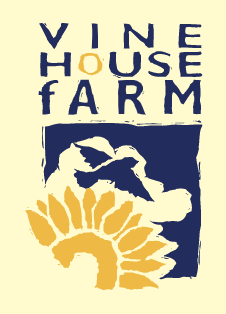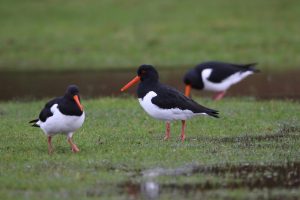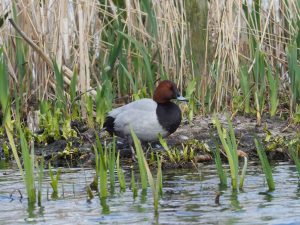
The sunny weather continues, three consecutive months of sunshine and less than 2ins of rain in those three months. With so much sunshine, May has been warmer than usual with an average temperature of 13.2°C. We’ve not had any rain in May and the only time when there has been a dry calendar month since 1829, in the Spalding area, was February 1891.
My weather records go back 50 years, any rainfall records older than that come from the Welland and Deepings Internal Drainage board who have kept rainfall records since 1829. This was the year when we ceased to rely on wind power to take our surplus water out to sea – we installed two steam pumping engines at Pode Hole, near Spalding, which gradually transformed the area to what it is now. Within a few years, brick houses were being built in the village as the land dried out and a church was built in 1846.

May has been another very busy month for us, on the farm, in the shop and with our mail order business. Most of our office staff are working from home and we have had to employ a few more people to keep up with demand. We have stringent social distancing measures and fortunately we have not had any cases of the invisible enemy.
All the crops have been drilled and all are growing, but there are some gaps where seeds haven’t germinated. This is because where the seed was placed was not in moisture. This spring has been unusual for three reasons: we have had so much to drill, as we were unable to drill last autumn because of the wet weather; as the mild winter did not produce any frost mould, the seed bed, after being worked, became small cobbles which let the dry weather into the soil; we have had so many of days when we have had sunshine and drying winds.
We’ve been going round the farm with irrigators to help some crops get going. To irrigate our crops, we must have a licence which gives us the amount of water that we are allowed to use – by the hour and by the day. It all has to be logged daily with where we are able to extract water from, ponds, water courses or reservoirs and our records have to be sent into the Environment Agency at the end of the year. There are big fines if our records are not complete, or if we use more water than we are allowed. No one knows what the weather is going to do in a month’s time, and we know that our crops need water now, so we are using it.
As the sunflower seed is a big seed, we were able to drill them twice the depth of millet or canary seed. They went into the moisture and are now all up and we have more plants per acre than ever before. For some reason, the pigeons haven’t found them – the cotyledons of an emerging sunflower plant are usually irresistible to a pigeon. When the seed starts to grow it puts shoot down and the seed is pushed up, breaking into two, to form the cotyledons.
With no rain in May and above average sunshine it is getting very dry. I have been asked, once or twice, is it drier now than it was at this time in 1976? The answer is no, because the winter of 1975/6 was very dry, so the water table in 1976 would be a lot lower than it is now. I am talking about around Spalding, Bourne and Market Deeping, of course.
We are now selling the potatoes that we lifted in March. They are not of the best quality as they have a few slug holes in them. They don’t look very pretty, certainly not pretty enough to grace the shelves of supermarkets, so they are going for peeling, to make potato salad or ready meals.


Doing my annual surveys of our farmland has been very enjoyable this year. I have had so many clear and sunny mornings – the air has been clearer, and I’ve been able to hear birds further away than I have done in the past. I don’t have all the results yet, but I have noted that Skylark numbers are down possibly due to their nests being flooded out last June, when we had more than 4ins of rain in a week. Sedge Warbler numbers are keeping up, and on one block of 700 acres we have 40 pairs. That is due to us having not filled in dykes to make larger fields.
We have several Blackcaps in the Fen which nest in small areas of woodland, but in one unused neglected farm yard which is full of nettles, elder bushes and on one side horse chestnut trees we have a Garden Warbler that has taken up residence. It is very difficult to see as it always singing from inside the elder bushes.
The wetland in Baston Fen has been attracting a lot of interesting species – both visiting and breeding. Generally, when I visit I see six species of ducks, five of them breeding, and seven species of waders, six of which are breeding. As you can see from the picture, it’s not just a bit of wet grassland. A few years ago, we had a bulldozer in to make the area like a giant rig and furrow. It’s turned out better than we could have expected and is complimented by the Baston Fen nature reserve which it borders.
The species of ducks we have breeding are Mallard, Gadwall, Shoveler, Tufted Ducks – several pairs of each and a pair of Shelducks. There has been a pair of Garganey on site for two weeks, so they could also be breeding. We have Lapwings, Redshanks, Oystercatchers, Little Ringed and Ringed Plovers and now a pair of Avocets on site. During the past six weeks, I have also seen Dunlin, Whimbrel, Jack, and Common Snipe, Greenshank, Common and Green Sandpiper. We have also Pied and Yellow Wagtails, Meadow Pipits and Skylarks breeding.
It has been all go in the Vine House Farm garden these last three months, undoubtedly it is the most interesting time of the year to feed birds in the garden. Live mealworms are the star attraction. They are fed in a caged live food feeder (made by Kernel)which the Starlings cannot get into, but they wait outside hoping to mug one of the House Sparrows coming out with a beak full of mealworms. Blue and Great Tits are far too quick to get mugged; the Robins and Chaffinches stand back and wait until there are no Starlings and Blackbirds around before going in.
The Sparrows are not so cautious and occasionally the Starlings will close into the cage and fluster the Sparrow, which then drops mealworms and come out with nothing. Others get their beaks full of mealworms and come out to meet the Starlings with varying results. Live mealworms are a complete food for a nestling – insects are in short supply, so that is why they are so sought after. They can see a pot full of juicy larvae and of course a parent wants the very best for their babies.
Live mealworms are so good for the nestlings as they are moist. Birds are unable to take their young water, so the water must be included in the food. You can try soaking dried mealworms, but when you have soaked them they are still not moist. If we want to see a lot of birds, we have to breed a lot of birds and studies have shown that by feeding live mealworms we will rear 50% more birds in our gardens.



